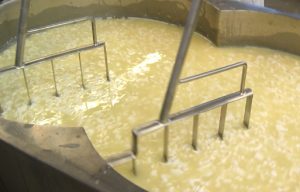
Environmental Monitoring of Nitrates and Other Water Quality Parameters: pH,
Environmental Monitoring of Nitrates and Other Water Quality Parameters: pH,...

Cheese is a versatile food that is valued worldwide for its high nutritional value and long shelf life. Cheeses are typically made from the coagulation and fermentation of milk from livestock mammals such as goats, sheep, or cows. There exist hundreds of cheese varieties, all prepared with differing compositions and techniques. As a result of this variance and complexity in production, cheese is the most diverse form of a dairy product. Read about the importance of measuring pH in Dairy products.

Throughout the cheesemaking process, pH control is critical to ensure consistent fermentation and food safety. If the pH is too low, the cheese may be prone to a brittle or pasty texture, as well as growth of mould after packaging. If the pH is too high, the cheese may become too firm, and can potentially be dangerous for consumption due to the risk of pathogen formation. The pH must be carefully monitored to detect deviations from the optimal range, which can create problems with texture, taste and public safety of cheese.
Acidification of milk begins with the addition of bacterial culture and rennet. The bacteria consume lactose and create lactic acid as a byproduct of fermentation. The lactic acid produced will cause the pH of the milk to go down. Once the milk reaches a particular pH, the rennet is added. The enzymes in rennet help to speed up curdling and create a firmer substance. For cheesemakers that dilute their rennet, the pH of the dilution water is also critical; water that is near pH 7 or higher can deactivate the rennet, causing problems with coagulation.

Once the curds are cut, stirred, and cooked, the liquid whey must be drained. The pH of whey at draining directly affects the composition and texture of the final cheese product. Whey that has a relatively high pH contributes to higher levels of calcium and phosphate and results in a stronger curd. Typical pH levels at draining can vary depending on the type of cheese; for example, Swiss cheese is drained between pH 6.3 and 6.5 while Cheddar cheese is drained between pH 6.0 and 6.2.
During brining, the cheese soaks up salt from the brine solution and loses excess moisture. The pH of the brine solution should be close to the pH of the cheese, ensuring equilibrium of ions like calcium and hydrogen. If there is an imbalance during brining, the final product can have rind defects, discoloration, a weakened texture, and a shorter shelf life.
Cheeses must fall within a narrow pH range to provide an optimal environment for microbial and enzymatic processes that occur during ripening. Bacterial cultures used in ripening are responsible for familiar characteristics such as the holes in Swiss cheese, the white mold on Brie rinds, and the aroma of Limburger cheese. A deviation from the ideal pH is not only detrimental to the ecology of the bacteria, but also to the cheese structure. Higher pH levels can result in cheeses that are more elastic while lower pH levels can cause brittleness.

Cheese products can provide a number of challenges for the person that needs to measure pH. Cheese products tend to be solid to semi-solids. Both types of samples will coat the sensitive glass membrane surface and/or clog the reference junction of the standard pH electrode. This is why Hanna instruments created the FC2423 cheese specific electrode that is supplied with the HI98165 pH meter. From a conic tip shape in a durable 5 mm diameter stainless steel body for easy penetration into cheese without leaving a large hole to an open junction that resist clogging; the FC2423 is an ideal general-purpose pH electrode for cheese. The FC2423 connects to the HI98165 with a quick-connect, waterproof DIN connector, allowing for a secure, non-threaded attachment.
Besides being supplied with a unique pH electrode made for cheese, the HI98165 has the Hanna’s unique CAL Check™ feature that alerts the user to potential problems during the calibration process. This is a very important for the food processor since it is likely that the probe will be coated with the solids found in the food product being measured. This coating can easily lead to errors in pH measurement. By comparing previous calibration data to the current calibration, the meter will inform the user, with display prompts, when the probe needs to be cleaned, replaced, or if the pH buffer might be contaminated. After calibration, the overall probe condition is displayed on screen as a percentage from 0 to 100% in increments of 10%. The probe condition is affected by both the offset and slope characteristics of the pH electrode, both of which can be found in the GLP data.
Pressing the “AutoHold” virtual key in measurement mode, the meter will freeze and automatically log a stable reading. An “out of calibration range” warning can be enabled that will alert the user when a reading is not within the bracket of calibrated pH values.
The log-on-demand mode allows the user to record and save up to 200 samples. The logged data, along with the associated GLP data, can then be recalled or transferred to a PC with Hanna’s HI920015 micro USB cable and HI92000 software for traceability in record keeping for specific product batches. GLP data includes date, time, calibration buffers, offset, and slope, and is directly accessible by pressing the dedicated GLP key.
A contextual help menu based on the screen that is currently being viewed can be accessed at any time by the press of a dedicated button.
The high contrast, graphic LCD screen is easy to view outdoors in bright sunlight as well as in low-lit areas with the backlight. A combination of dedicated and virtual keys allows for easy, intuitive meter operation in a choice of languages.
The compact, durable carry case is thermoformed to hold all necessary components for taking a field measurement, including the meter and electrode, beakers, buffer solutions and cleaning solutions.
Environmental Monitoring of Nitrates and Other Water Quality Parameters: pH,...
Salt Concentration In A Brine Solution For Curing Salmon Traditionally,...

To empower customers to achieve quality by supplying intuitive, accurate, and reliable analytical instruments with exceptional customer service and value.
We take pride in every product we build. From an original idea to a completed product ready for testing. We oversee every aspect of the manufacturing process. It is this level of attention to detail that sets us apart.
To empower customers to achieve quality by supplying intuitive, accurate, and reliable analytical instruments with exceptional customer service and value.
We take pride in every product we build. From an original idea, to a completed product ready for testing. We oversee every aspect of the manufacturing process. It is this level of attention to detail that sets us apart.
To empower customers to achieve quality by supplying intuitive, accurate, and reliable analytical instruments with exceptional customer service and value.
We take pride in every product we build. From an original idea, to a completed product ready for testing. We oversee every aspect of the manufacturing process. It is this level of attention to detail that sets us apart.

